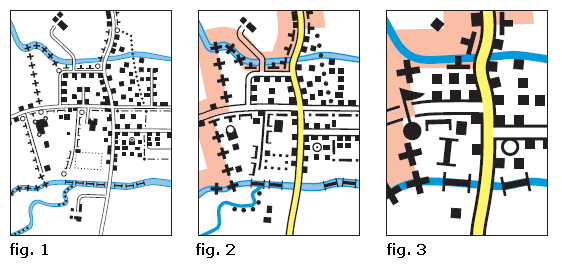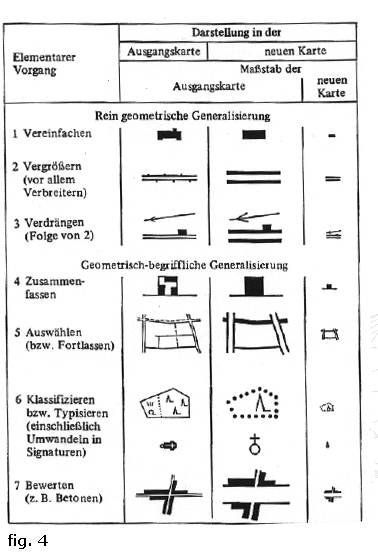Teaching:TUW - UE InfoVis WS 2007/08 - Gruppe 05 - Aufgabe 1 - Generalization
Generalization[edit]
Generalization is the abstraction away from aspects of the reality which are not important for some analysis or question at hand.
Definition[edit]
A. Hettner defines Generalization as
„… a selection of the most important, the essence and the target-oriented simplification. In this process, it is important that the map shows the most important, characteristically attributes, which are needed for the use, the topic and the scale of the map.“
Overview[edit]
An important area of generalization techniques is the field of visualizing geographical information and geo-spacial data in 2D maps. Here, in order to make a specific kind of information easily graspable, it is necessary to suppress unnecessary information. An example might be routes in a navigation system: to make it easy to recognize and understand the route, it is important to include necessary information, e.g. roads or landmarks along the route, but suppress unnecessary detail like roads or geographical entities away from the route that are not important for locating points on or following along the route (Agrawala2001).
It depends on the scale, which information can be shown on a map. The designer of a printed map can decide, which information is shown (i.e. toponyomies, name of the streets, rivers…) and on which position within the map this information should be placed. But digital maps aren´t produced in traditional way. Users can zoom within these maps. It depends on the zoom-factor, which information is shown. The computer has to decide, which information is shown on which position. For this procedure algorithms are needed.
Goals of generalization[edit]
- Improve the message of the map
- Improve the communication of the content of the map
- Improve the speed of the collection of data
- Help to find answers on questions
- The shown information should be useful for the target-audience (i.e. maps for traffic-engineers, city-engineers, environment-engineers…)
When should be generalized?[edit]
- If a map has too much information. Then it´s hard to understand the information (i.e. different symbols, Overlapping of symbols, colors…)
- If a map is designed only for a special audience and only a special conclusion is needed
- If information could be combined
- If maps lose their character because there are too much of information
- If important information is unnoticed
- If objects are too small, if they are shown in „correct“ scale
Kinds of generalization?[edit]
- Simplifications (i.e. defines of shapes)
- Straighten (i.e. curve)
- Aggregation (i.e. arrangement of objects)
- Combination (z. B. important information overlap less important information)
- Union (i.e. many objects are combined to one)
- Change the symbols (i.e. from shape-symbols to point-symbols)
Examples[edit]
All 3 figures show the same segment of the map
Figure 1 shows the most details. The shapes of the buildings are not simplified yet. This map doesn´t show the main-street.
Figure 2 shows with the color yellow the main-street. The shapes of the building are simplified (only rectangles are shown). The quantity of the buildings is not equal with the “real” quantity.
Figure 3 doesn´t show details like some streets or the little river on the bottom-left side. The building in the middle is now presented with a flag. This visualization doesn´t represent the reality, but it increases the important of the building
Figure 4 shows more examples of generalization
References[edit]
[Agrawala, 2001] Maneesh Agrawala and Chris Stolte, Rendering Effective Route Maps: Improving Usability Through Generalization. SIGGRAPH 2001, Computer Graphics Proceedings. ACM Press / ACM SIGGRAPH.
[Sester, 2001] Monika Sester, Maßstabdsabhängige Darstellung in digitalen räumlichen Datenbeständen, Universität Stuttgart, http://www.ikg.uni-hannover.de/publikationen/publikationen/2001/sester_habil.pdf
[swisstopo, 2001] Schweizer Gesellschaft für Kartographie, Topografische Karten Kartengrafik und Generalisierung, http://www.swisstopo.ch/pub/down/basics/karto/demoNo16_de.pdf
[Möltgen, 2003] Jörn Möltgen, Generalisierung, Universität Münster, http://ifgi.uni-muenster.de/~moltgej/Lehre/Karto_SS2003/7.Generalisierung.pdf
All pictures are taken from this publications

